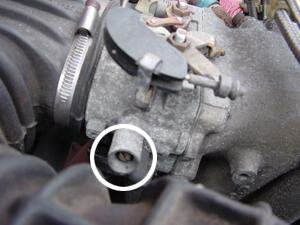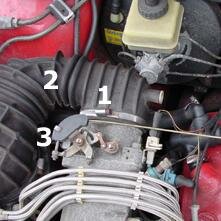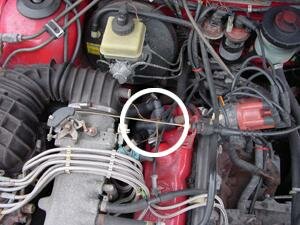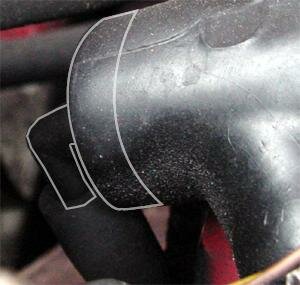My 1985+ Audi Coupe GT Tips
This article was written for the Audi Club of North America some time ago. I'd forgotten all about it until a reader sent me a question about it. So I recovered the article and made sure it existed as part of my car pages. If you're interested, my original version, in-context, is here : Chris's GT5 Tips
Headlights.
The reflectors are prone to rot in these models. There's 4 of them, 2 each side. One each side is for the dipped/main beam, and the other is for the high-beam lights. New reflectors can be bought from The Parts Department in Brighton. (01273 326189). These are genuine VAG parts but without the VAG price tag. The Parts Department specialise mainly in Ur-Quattro models, but some share their headlights with the Coupe GT hence the ability to get reflectors there. The headlight adjuster screws and levers on the backs of the lights are all original items and you'll need to get them from a VAG dealer.
Tail-light clusters.
All components of the tail-lights are dealer-only items - you'll need to get them from VAG dealers but they're not too bad. A complete unit will set you back about £69.
Windscreen wipers.
Because of the shape of the windscreen, most owners put mismatched sizes of windscreen wiper on the front. Typically a 21inch drivers-side blade and a 19inch passenger side blade. Drive with two 19inch blades and you'll soon see why most people add a larger one.
Hydraulic clutch cylinders.
Generally good. My master cylinder is fine at 169,000 miles, but the slave cylinder needed replacing at around 80,000 miles. It's a 15 minute job with the right tools, but if you're doing it yourself, make sure you bleed the hydraulic system afterwards or you'll lose the clutch.
Air Filters.
Stock VAG air filters suffocate the JS engine. Replace it with a Jamex item. Getting at the airbox to replace the filter is a problem in the Coupe because it's so jammed under the front wing that access is severely limited. You'll need fingers of steel or a good hook-shaped puller to just get the clips off to take it apart! It's worth the effort though. The engine revs far more freely for the sake of a £20 air filter!
Exhaust system.
Composed of a 5-into-2 exhaust manifold, connected to a 2-into-1 downpipe that runs down the engine bulkhead and under the centre of the car. The centre silencer pipe comes next, which in turn is connected to the rear silencer. The rear silencer comes with a complex-bend pipe that hooks over the rear suspension beam. Audi parts are prohibitively expensive, but you can get good quality german exhausts manufactured by a company called Ë. Their exhausts are made from thick, weapons-grade stainless steel and last longer than the original Audi items. They're available through OE suppliers like German & Swedish. Their Reading branch is contactable on 0118 987 3030 where they'll give you the numbers for their branches all over the UK.
Suspension & Steering.
Power steering racks can be had for about £50 from a breaker's yard if yours is leaking. Make sure it's been reconditioned and make sure the seals are all new. That's the cheap bit. The expensive bit is getting someone to fit it for you. It takes a massive amount of effort and quite a complex bit of engine disassembly to replace the rack. Not to be tried at home!
The suspension is MacPherson struts at the front, and trailing-link panhard rod solid axle at the rear. The front struts generally don't have any mechanical problems, but you will need to replace the springs and shock absorbers every 75,000 miles or so because the front end is bloody heavy on the Audi and it wears the suspension components quite quickly. The rear shocks and springs should be replaced at the same time, even if they don't really need it or you'll end up with a car that sits unevenly. Get quality springs from German & Swedish or an aftermarket supplier like Monroe or Jamex. Do not go to EuroCarParts. I ordered a complete set of springs from them as well as shock absorbers. When they arrived, 3 of the 4 shocks were leaking, and both front springs were oval instead of round. Needless to say, they didn't fit in the struts. ECP refused to pay for the return postage so I had to borrow a car and go down there to get the parts exchanged. They charged £20 an item to restock and replace (3 shocks and 2 springs = £100). The new springs were round, but had been manually sawn-off from longer springs, and the two new shocks were uneven lengths. I eventually got all my money back and went elsewhere. ECP is run by a bunch of pirates of the asian persuasion who care more about getting your money and less about giving you what you pay for. Use them at your peril!
The steering geometry can be changed and tweaked at a decent suspension / tyre fitters with bolts available to change caster, camber and toe-in/out. The rear suspension however is set at the factory and cannot be changed. If your Audi 'crabs' along the road, the panhard rod is bent and you need a complete rear suspension refit.
Brakes.
Front brake discs can warp in extreme circumstances, but it's not common. They typically last about 55,000 miles before needing replacing. Pads should be replaced when they're worn. The original Audi rubber brake hoses leave a lot to be desired. Replace them with AeroQuip steel-braided brake hoses and you'll notice a marked increase in the feel of the brake pedal in the car. The reason is that the old rubber hoses tend to 'give' a lot and expand when put under pressure. The steel-braided ones don't, so all your foot-pedal pressure goes direct to the brakes.
The handbrake cables rust and seize up with monotonous regularity. Good quality after-market items can be had for about £16 from German & Swedish. Takes about 30 minutes to replace if you've got access to a hydraulic ramp. Impossible to replace if you're trying to do it lying under the car on the ground.
Engine Information specific to JS-series 5 cylinder 1994cc engine, with K-Jetronic injection system.
Manufactured from 8/83 (JS 002 415) to 7/87 (JS 075 780)
Displacement: 1994cc
Bore/stroke: 81.0 / 77.4
Compression ratio: 10.0:1
Power output: 85kW / 115bhp @ 5400rpm
Max. torque: 165Nm / 123lb ft @ 3200rpm
Minimum fuel octane : 98RON
Inlet valve diameter: 37mm
Exhaust valve diameter : 30mm
Tappets : Bucket
Valve clearance (warm): inlet 0.2mm-0.3mm exhaust 0.4mm-0.5mm
Valve timing.
Inlet opens 0.5 BTDC
Inlet closes 37 ATDC
Exhaust opens 37 BTDC
Exhaust closes 1 ATDC
Fuel injection system : Bosch K-Jetronic (mechanical fuel injection regulator)
Idle speed - 800-900rpm
Oil capacity - 3.5litres without filter, 4litres with filter
Despite it's name, the K-Jetronic system is an entirely mechanical system, and is generally very reliable. Fuel is pressurised into a chamber by the pump under the fuel tank at the back of the car. An airflow flap hangs down inside the air intake from the air filter, and is connected by mechanical levers to a pressure regulator inside the fuel chamber. The more air passes the flap, the more it is pushed up, and the more fuel it allows through to the injectors.
The throttle has two butterfly valves. The smaller of the two is used for most driving, but press the accelerator past the point where you feel some resistance, and the second butterfly opens allowing the engine to gulp fuel/air mix at a massive rate and boost the power.
Use super-unleaded petrol - it's the correct octane rating. If you use regular unleaded, you'll need to retard the ignition by 9 degrees which will effectively turn your 2.0litre engine into a 1.6litre engine that sounds like a box of bolts. It's horrible!
Don't use Lead-Replacement Petrol (LRP). The sulphates that they use to replace the lead eventually oxidise into sulphuric acid when your engine cools, and after a very short time, that acid will etch the valves, valve seats, cylinder walls and piston rings, and then you'll need a complete new engine top-end.
Rough-idling and stalling when you clutch-in and take your foot off the gas.
This is a common affliction of the JS engines. They get all lumpy at idle, hunting between 400 and 800rpm and generally feeling rough. When you're at speed and you clutch-in and take your foot off the gas, the engine will drop revs to around 800rpm, then to 400rpm and in a lot of cases it will then stall. This makes driving the buggers a complete nightmare, but it can be solved so simply. The design of the air passage around the idle-speed adjustment screw is complex on the K-Jetronic system, and like a river desposits sand on the outside of a bend, the airflow around the idle screw deposits carbon all over the pointed end of the screw. The JS engines are particularly sensitive to the CO2/air mix that this screw controls and even a mild buildup of cack on the screw can cause all sorts of running problems. The solution is simple - unscrew the screw all the way out of the side of the throttle-body. As you look down on the engine, it's a recessed screw in the left-side of the throttle body, typically copper, with a flat-head screwdriver drive in it.
 |
| Idle speed adjuster screw |
It sits horizontally screwing in from the left of the throttle body to the right. Once it's out, you'll see the end of it is tapered and will invariable be covered in what looks like treacle. Clean this all off using a basic carburettor cleaner aerosol. Now get someone to start the engine for you whilst holding your thumb over the hole the screw came out of. The engine will start to suck hard on your thumb. Take it away and spray a load of carb' cleaner into the hole - the engine will probably need to be held on the throttle to stop it stalling. Once you've done that, screw the idle-screw back in and tighten it slowly until the engine idles neatly at 900rpm and all your problems will be solved.
Other rough-running remedys.
The edges of the throttle butterfly valves can get coked up easily too. Loosen the jubilee clip that holds the rubber air intake manifold to the back of the throttle body (1, in the image below) and pull the rubber boot off (2). Look inside and you'll see the two throttle butterflies. Hold the throttle full-open with your thumb (3) and spray carb-cleaner into them and wipe around them gently with your finger inside a rag. Be careful if you use a screwdriver with a rag around it, because the metal in there is soft and if you score it badly, you'll need a new throttle body. And that's expensive! Also wipe around the sides of the throttle body where the butterflies rest when closed. You'll get a lot of black carbon residue off there.
Also make sure you don't drop anything into the holes where the butterfly valves are. If you do, you'll need to disassemble the entire intake manifold to get it out, or it will get sucked into the engine!
 |
| Throttle butterfly location |
Oil-soaked air filter?
The oil-vapour scavenging system often blocks in the JS engine resulting in oil condensing in the intake manifolds and running back down into the air filter. If your air filter is all oily, this is how to solve it.
At the top, back of the rocker cover is a relatively thick rubber hose that leads down to a large rubber junction-piece, connected to two other hoses.
 |
| Location of rubber junction piece |
Loosen all the clips down there and wiggle that big rubber piece out. At the bottom of it there's a plastic piece with a right-angled elbow in it. Pull the plastic piece out of the rubber junction hose and examine it.
 |
| The plastic elbow piece resides in the end of the rubber junction piece. |
Blow into one end - you should be able to blow freely. If you're eyes pop out, or you faint, then the elbow is blocked. Spray carb-cleaner into it, or WD40 and blow from the little elbow piece back the other way. You might need to use an unwound paper clip to poke the carbon deposits out. Either way, spend a good amount of time cleaning that little hole that runs through the plastic elbow until you can blow through it both ways unobstructed. Once it's clear, pop it back in the rubber junction piece and connect all the hoses back to it. You probably should clean the intake manifold of the excess oil, but now that that tiny little hole in the plastic elbow is clear again, the engine can scavenge the oil vapours properly and your air filter should eventually dry out.
Weights, measures, performance
Overall length / width / height : 4421mm / 1682mm / 1350mm
Wheelbase : 2538mm
Track front / rear : 1395mm / 1420mm
Minimum ground clearance : 119mm
Unladen weight : 1060kg
Gas-mileage
Urban : 27.2mpg
Economy : 35.5mpg
Constant 56mph : 42.2mpg
Constant 75mph : 33.6mpg
Max speed : 118mph
0-50mph : 7.0 sec
0-60mph : 9.6 sec
0-70mph : 12.7 sec
30-50mph (3rd gear) : 4.4 sec
30-50mph (4th gear) : 6.9 sec
50-70mph (4th gear) : 6.7 sec
50-70mph (5th gear) : 9.0 sec
Road speed per 1000 revs in top gear : 22.2mph / 1000 revs
Workshop manuals, technical books
Haynes do a workshop manual that covers the Audi Coupe GT. Manual Number 605.
The original Audi parts manual with exploded technical diagrams of every element of the car (the same ones they see on the microfilm when you go to a VAG dealer looking for spares) are available from Karmann Classics in Brighton on 01273 424330.
OE Aftermarket suppliers.
Do use:
German & Swedish : 0118 987 3030
The Parts Department : 01273 326189
Do not use:
Euro Car Parts (see the suspension section for details why!)